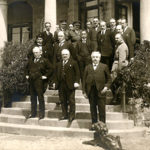Published July 23, 1999
LBMC Report
Liberal Democrats, Congressional Republicans, and Alan Greenspan often disagree with one another. But they have one thing in common; all have been puzzled by the behavior of the U.S. labor market.
Liberals who had predicted the failure of welfare reform were surprised by its success. Republicans who watched the economy behave worse than they expected under President Bush, found it better than they expected under President Clinton. Federal Reserve Chairman Greenspan has been surprised that unemployment could fall further than he used to say was possible without an upturn in “core” inflation.
There is an obvious connection, but no one has yet drawn ii: an expansion of welfare under President Bush raised the so-called “natural” rate of unemployment and lowered national output; but welfare reform agreed to by Congressional Republicans and President Clinton in 1996 has lowered unemployment and raised national output. I stated this thesis in 1993 and 1994, before welfare reform was enacted. Now the evidence is available to prove it.
The Liberal Democrats’ Puzzle
Liberal Democrats had opposed welfare reform and predicted its failure, saying that those denied welfare benefits would be unable to find jobs. Yet welfare reform has been a resounding success: the welfare caseload has dropped nearly in half, and most of the able-bodied former welfare recipients now have jobs. (Nationwide welfare reform was enacted in August 1996, but experiments had begun a few years earlier in many stales under Federal waivers.)
The liberals’ after-the-fact conclusion: it was simply lucky that welfare reform coincided with a good economy. But this doesn’t wash. In its February 1999 Economic Report to the President, the Council of Economic Advisers agreed that “today’s strong labor market is… easing the implementation of the 1996 welfare reform act.” However, the CEA Report goes on to say that “the improvement in the labor market can explain an 8.3 percent drop in welfare caseloads. Given that the national welfare caseload actually fell by 42.3 percent during this period [1994 to 1998], it appears that improved labor market conditions were responsible for roughly one-fifth of that decline” (p. 119).
The puzzle for the liberals, then, is this: why was welfare reform about five times as successful as even its lukewarm advocates had expected?
The GOP Puzzle
The puzzle for Republicans is why the economy performed so much more poorly than they expected under President Bush, but so much better than they expected under President Clinton. Mr. Clinton, of course, always had the advantage of business-cycle timing over Mr. Bush. President Bush inherited an economy with rising inflation, to which the Federal Reserve responded by raising interest rates, leading to the 1990 recession. Yet economic recovery began in the second quarter of 1991, a year and a half before, the 1992 Presidential election in which Mr. Bush was defeated. The unemployment rate, breaking with precedent, continued to rise for more than a year after national output began to bounce back, and was substantially higher on Election Day 1992 (7.3%) than when the recovery began (6.8%). Subsequently, the Republicans have observed the Clinton Administration enjoying not only a business cycle upswing, but one in which the unemployment rate fell to its lowest level in nearly 30 years, while inflation continued to decline.
Alan Greenspan’s Puzzle
This leads us to Alan Greenspan’s puzzle. During Greenspan’s July 22 semiannual Humphrey-Hawkins testimony to the House Banking Committee, Rep. Melvin Watt (D-NC) reminded him: “the first time you gave this report and I was on this committee, I was kind of shocked to hear you say that you thought, as I recall, that if unemployment fell below 5, 5-1/2 percent, that was going to be dangerous.”
Greenspan had received similar questions on June 17 from members of the Joint Economic Committee, who questioned him about his views of the Non-Accelerating Inflation Rate of Unemployment, or NAIRU. Rep. Thomas Ewing (R-IL) noted, “It’s interesting for me to hear that you seem to believe these old units of measurement are no longer as valid as I seem to recollect hearing in the past.”
Greenspan conceded June 17 that “many of the empirical regularities…on which policymakers rely have been markedly altered. The Federal Reserve has thus been pressed to continuously update our understanding of how the newer forces are developing.”
In earlier years, Greenspan had been solidly within the economic mainstream. In fact, the Congressional Budget Office still estimates that NAIRU is equal to 5.6%. Thus at 4.2% the unemployment rate ought to be far below the level at which “core” inflation should be accelerating. In fact, the unemployment rate fell below 5.6% three years ago, in June of 1996 — yet the “core” inflation rate continued what is now a 9-year decline.
Greenspan has more recently emphasized the acceleration of productivity due to the revolution in information technology. But the Federal Reserve chairman is aware that this does not solve the puzzle. The contribution of advanced technology to the growth rate of labor productivity can explain why the growth of output is higher at any given rate of unemployment. But it cannot explain why unemployment would decline to the lowest level since 1970s, yet co-exist with relatively low and declining “core” inflation.
Greenspan has apparently concluded that the “natural” rate of unemployment must have declined for still-unexplained reasons — but that there is still some rate at which unit labor costs and “core” inflation will begin to accelerate. “There is still a limits question. And it’s not as though there are no limits whatever,” Greenspan testified June 17th. The only way to know when this point is reached, in his view, is for the Federal Reserve to be alert to evidence of rising labor costs. Hence the Fed will take its cues from the real economy, and set policy from month to month. This makes Mr. Greenspan nervous, because there is a lag of a year or more between a policy change and its effect on the economy.
The Answer
Only one explanation solves all three puzzles: changes to welfare programs raised the unemployment rate and lowered national output under President Bush, but welfare reform has reduced unemployment and raised output under President Clinton.
In 1993 and 1994, I wrote a series of monographs showing that the unemployment rate is related to net unit labor costs (see references). The main innovation was not in the theory — every economist agrees in principle that a higher cost of hiring reduces employment — but in the measurement: adjusting labor costs for the effect of taxes and transfer payments.
All national output results from combining the services of labor and of capital (or of “human capital” and “nonhuman capital”). And theory suggests that the income resulting from this production will be split according to the contribution each factor makes to increased output. The share of income received by workers as labor compensation is equivalent in principle to the “real unit labor cost” –compensation per hour, adjusted for output per hour (.labor productivity) and for output prices.
Rueff’s Law
Before World War II, French economist Jacques Rueff had showed that real unit labor costs explained the variation of unemployment rates in the United Kingdom and other countries. The relation between the two became known as “Rueff’s Law.” Since the Second World War, however, the conventionally defined real unit labor cost has had relatively little correlation with the unemployment rate. (See Graph 1.) The reason, I found, is that labor and property compensation are conventionally measured without adjustment for taxes and transfer payments. Though income is produced by labor and capital, the income is split three ways: part goes to workers as take-home pay; part goes to property owners as after-tax property compensation (interest, dividends, retained earnings and rent); and part goes to persons who do not contribute to output, as “transfer payments.”
Under these circumstances, the net cost of labor is the share of income not received by owners of property — that is, take-home pay plus transfer payments, as a share of total national income. This after-tax, after-transfer measure of labor costs has a very close relation with the unemployment rate, both before and after World War II. (See Graph 2.) The lower the net labor cost, the lower the unemployment rate — and the higher the total national output and income. Each 1 percentage point rise in net labor cost, as a share of national income, is associated with a 0.8 percentage point rise in the unemployment rate. (See Graph 3.) Since workers are necessary for production, each 1 percentage point rise in net labor cost is also associated with a 2 percentage point decline in national income, compared with “potential output” — what could be produced if all workers and equipment were fully employed. (See Graph 4.)
Different Transfer Payments
Some government transfer payments can affect the net cost of labor, while others do not. Generally speaking, there are three kinds of transfer payments. Transfer payments to people of working age, if not conditioned on having a job, effectively place an above-market floor under rates of compensation: because at some point it is more attractive to collect benefits without working. Such benefits include unemployment compensation and welfare to the able-bodied. Other government benefits are available only to persons outside the labor force; for example, Social Security retirement or disability benefits. Such benefits don’t put a floor under wage rates: they are financed by reducing the take-home pay of workers. Instead of raising unemployment, they may reduce employment by encouraging retirement, from the workforce. The third category of transfer payments consists of benefits conditioned on working — for example, the earned income tax credit, wage subsidies, or “workfare” benefits. Such benefits neither raise unemployment nor reduce aggregate take-home pay: the income is redistributed from some workers to other workers.
The essential difference between the United States and Europe is not in the magnitude, but rather the different mix, of transfer payments. “Since the 1960s, benefits to the unemployed have increased more sharply in Europe — increasing unemployment faster — while benefits to persons outside the labor force have increased more rapidly in the U .S. — causing a sharper decline in take-home pay as a share of national income” (1994b,7).
In the United States, I showed that “the entire upward trend of labor’s share of national income since 1960 is accounted for by welfare to the able-bodied… And more than 1 percentage point of unemployment was added just since 1988 — thanks in large measure to the Bush administration’s acquiescence in large benefit increases, particularly for Medicaid” (1994a, 11-12). The expansion of welfare under the Bush Administration was part of Richard Darman’s 1990 budget deal. The share of the U.S. population on welfare rose by about 25% in the next four years.
Dramatic welfare reform, I argued, could reverse the process. “For each 1 percentage point of national income less in welfare to the able-bodied unemployed (accomplished, for example, by conditioning welfare and Medicaid to the able-bodied on having a job) unemployment would decline 0.8 and real national output and income rise about 2%…. But that would require more ambitious reform than proposed by the [1994 GOP] Contract [with America]” (LBMC Report, 29 November 1994).
Two years later, a newly elected Republican Congress passed, and President Clinton signed, a sweeping welfare reform bill that ended the entitlement to welfare and imposed a time limit on receipt of benefits. The earned income lax credit was also expanded, increasing take-home pay for lower-income breadwinners without raising the cost of hiring.
The Proof
The result? The share of the U.S. population on welfare, after increasing by more than 25% from 1988 to 1993, declined by nearly half between 1994 and 1998. (See Graph 5.) And studies have shown that most of the able-bodied former recipients have found employment in the private sector.
This was possible because the changes in the welfare laws reduced the cost of hiring, thus increasing the demand for workers and expanding output. Commerce Department data show that government transfer payments of all kinds declined by 1.3 percentage points of national income. About two-thirds of the decline was due to welfare (Food Stamps, AFDC/TANF, and Medicaid to the non-elderly), while the rest was due to the normal cyclical swing in unemployment insurance.
This reduction in net labor costs cut the unemployment rate by 1 percentage point, and increased national income by about 2-1/2 percentage points. (See Graph 6.) Unemployment was able to fall. and national output and income to rise, by that much more than otherwise would have been possible. Since unemployment declined from 7.5 in 1992 to 4.5 in 1998, changes in transfer payments — primarily due to welfare reform — were responsible for one-third of the decline in unemployment.
Conclusion
What can we learn from all this?
First, the notion of the “natural” unemployment rate needs some serious revision. “There is simply no such thing as ‘natural’ or ‘structural’ unemployment–in the sense of unemployment arising out of the nature or structure of the economy, beyond the reach of policymakers. There is such a thing as ‘institutional unemployment’ — but it comes from misguided attempt policies which legislate wage rates, and necessarily lower real labor income” (1994a, 16).
Second, what should the Federal Reserve watch to anticipate a rise in unit labor costs that might show up as rising “core” inflation? I have suggested observing employment in manufacturing. Though it constitutes a declining share of total employment, manufacturing is still the high-wage, high-productivity part of the U.S. economy. Manufacturing payrolls have dropped by nearly 500,000 in the past year and a half, while the national unemployment rate continued to decline. That the nation’s industry is able to produce more with fewer workers implies a continued rise in productivity and well-contained labor costs. Hence manufacturing payrolls are a better early warning signal for policymakers than the civilian unemployment rate.
Third, despite its success, welfare reform has been largely a political orphan. Someone should adopt it. Both Congress and the Administration should share the credit for enacting it — and for the resulting positive impact on the economy.
Earlier articles on this topic:
1993a: “Transfer Payments; Cause of Permanent Unemployment,” LBMC Report, 26 May
1993b. “The Cost of Social Spending – Joblessness.” Wall Street Journal, 13 July.
1993c: “Transfer Payments. Unemployment and the Clinton Health Plan,” LBMC Report. 26 August
1994a: “How Can Wages Fall While Unemployment Rises?”-LBMC Report, 11 March.
1994b: “A Challenge to Conventional Labor Market Wisdom.” LBMC Report, May
1996: ‘Don’t Round Up the Usual Suspects.” Harvard Business Review September-October, 126
Also: “Wedge versus social wage,” by Samuel Brittan. Financial Times, 21 July 1994.












